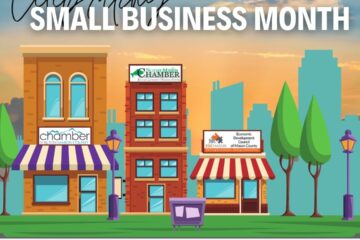Chamber Provides Overview of New COVID-19 Funding
The Chamber presented a webinar December 23 about the latest bipartisan bill passed by Congress to provide additional COVID relief, including $325 billion dedicated to small businesses. A second round of money could make the difference between surviving and closing for a struggling business.
Watch the webinar recording for the latest information about changes to the Paycheck Protection Program (PPP) and other emergency assistance options. The application period reopened January 11, 2021.
Additional guidelines and resources:
SBA guidance for new Pandemic Funding.
SBA online tool to find a local lender.
US Chamber Guide to Small Business COVID-19 Emergency Loans.
US Chamber website: Save Small Business Resource Center.
PPP Important Dates
January 11, 2021: First draw for community financial institutions
January 15, 2021: First and second draw for small lenders
January 19, 2021: First and second draw for all lenders
PPP Round Two Guidelines and Changes
Round one forgivable expenses included payroll, mortgage interest, rent, utilities; now also:
- Operations Software: business software, cloud computing, sales monitoring, backend HR & accounting services
- Supplier Costs; payments made to a supplier for goods essential to operation. The contract must be in effect before loan (with respect to perishable goods, it is in effect at any time)
- Worker Protection Expenses; PPE, outdoor seating, sneeze gards, etc.
- Covered Property Damage Costs; property damage and/or looting due to 2020 public disturbances not covered by insurance or other compensation
60/40 rule remains: 60% must be spent on payroll costs to be fully forgivable (there are some safe harbors that change this requirement).
Time period begins on loan origination date, borrower can choose end date to spend (8-24 weeks)
Calculation for loan amount can be the prior 12 months OR 2019 wages: the business gets to choose period for calculation.
PPP is not taxable income and the IRS cannot limit deductions (must allow normal business expenses).
If the loan is less than $150K the business must request forgiveness, but just one-page attestation (for both Rounds 1&2).
Independent contractors can apply for PPP for themselves, a separate business cannot do it on their behalf.
There is funding set aside for first-time PPP Applicants.
A second draw is available to some small businesses. The criteria is:
- You’ve exhausted round one funds
- You have less than 300 employees
- You can emonstrate at least 25% drop in gross receipts compared to last year or in any one quarter of 2020 compared to 2019 (COVID funding is should not be included in gross receipts)
Apply again even if denied first round; now housing co-ops, news media outlets, 501(c)6s qualify.
Small businesses can now receive the Employee Retention Credit and PPP; previously you had to choose.
Maximum is $2M, up to 2.5 months of payroll. Certain NAICS codes can get 3.5 months (accommodation and food service beginning with 72).
Forgiveness is reduced if you reduce more than 25% employee count OR hours. Unless it is because of COVID health restrictions and other safe harbors.
Live Venue Operations GRANTS
Live Venue grants are available to shuttered businesses such as theaters, arts, entertainment, and museums including, but not limited to live venue operators or promoters, theatrical producers, live performing arts organization operators, museum operators, motion picture theatre operators, or talent representatives.
To be eligible, the business must show a reduction of at least 25% in gross receipts (2020 compared to 2019). Business can get grant (will not need to be repaid or ask for forgiveness) of 45% of 2019 gross receipts up to $10M. Cannot get Round 2 PPP in tandem with this, it’s an either/or.
Changes to EIDL
Reopened the $10K grants for businesses with 300 or less employees located in a low-income neighborhood with more than 30% reduction in gross receipts during any 8-week period Mar 2-Dec 31, 2020.
Businesses will no longer to subtract the EIDL grant portion from PPP forgiveness, but it must be used on a different expense (no double dipping allowed).
Employee Retention Tax Credit (ERTC)
Now, eligible businesses of less than 500 employees can get both PPP and ERTC. 2020 limits are up to $5K per employee for the full year. Jan-Jun 2021, the tax credit is expanded to 70% of wages per employee ($7K each, Q1 and Q2, up to $14K total). Business must show reduction in gross receipts of 20% per quarter to qualify.
For 2020, businesses now have opportunity to claim ERTC even if they received PPP. Take a look back Q1-3 and count those wages toward that $10K cap. Businesses cannot claim credit for payroll paid with PPP (it’s considered double dipping).
PUA
Begins January 1 through mid-March (14?), extra $300/week.
Other
$25B for housing assistance designed to help those behind on rent.
SBA Loan Debt Forgiveness: The new law resumes the government payment of monthly principal and interest on small business loans guaranteed by the SBA under the 7(a), 504, and Microloan programs. Borrowers with loans approved by the SBA prior to the CARES Act will receive an additional three months of payments beginning in February of 2021. Those payments will be capped at $9,000 per borrower per month.

